- Preparing for Cold Weather Camping
- Clothing Systems for Winter Camping
- Shelter and Sleeping Gear Essentials
- Cooking and Food Storage in Winter
- Safety Tips and Extra Gear Recommendations
1. Preparing for Cold Weather Camping
Winter camping in the USA offers breathtaking landscapes and peaceful solitude, but it demands thorough preparation with the right gear. Unlike summer trips, cold weather camping pushes both your body and equipment to their limits. Before heading out, understanding how to prepare for freezing temperatures is crucial to ensure a safe and enjoyable experience.
First, research your destination’s climate carefully. For example, the Rocky Mountains and Sierra Nevada are known for heavy snowfall and harsh winds. Planning routes, identifying emergency shelters, and checking weather forecasts are essential steps. One winter camper shared how a sudden storm in Yellowstone nearly stranded him until his gear and preparation saved the day, emphasizing the value of reliable equipment.
Choosing essential gear for winter camping USA means prioritizing warmth, moisture management, and safety. The cold can be unforgiving, so selecting the right items isn’t just about comfort—it’s about survival.
2. Clothing Systems for Winter Camping
Proper clothing is the foundation of staying warm in winter. A well-designed layering system allows campers to regulate body temperature and avoid sweating, which can quickly lead to hypothermia.
2.1 Base Layers
The first layer should be moisture-wicking and insulating, usually made from merino wool or synthetic fabrics. Cotton is a strict no-go in winter camping because it traps moisture and cools the body.
2.2 Insulation Layers
Mid-layers, like fleece or down jackets, provide the bulk of your insulation. Down is lightweight and highly compressible but loses insulating power when wet. Synthetic insulated jackets are bulkier but perform better in damp conditions.
2.3 Outer Shell
The outer shell must be waterproof and windproof while remaining breathable to allow moisture escape. Gore-Tex or similar membranes are popular choices here.
One camper’s experience in the northern Cascades revealed how a trusted layering system enabled him to stay comfortable even during a week-long snowstorm. This personal story underlines why layering isn’t just theoretical advice but a proven technique.
3. Shelter and Sleeping Gear Essentials
Having a reliable shelter and sleeping system can make or break a winter camping trip. The cold ground and harsh elements require specialized gear beyond what’s used in mild seasons.
3.1 Four-Season Tents
Winter camping requires sturdy four-season tents designed to withstand snow loads and strong winds. Look for tents with strong poles, minimal mesh panels, and snow flaps to keep out drafts.
3.2 Sleeping Bags and Pads
A sleeping bag rated well below the expected temperature is crucial. Down sleeping bags are popular for their warmth-to-weight ratio but must be kept dry. Combining sleeping bags with insulated sleeping pads prevents heat loss to the ground. Closed-cell foam pads combined with inflatable insulated pads are a common setup for maximum warmth.
When winter backpacker Sarah camped in Colorado’s San Juan Mountains, her combination of a 0°F-rated sleeping bag and dual sleeping pads saved her from a chilling night that dipped below zero.
4. Cooking and Food Storage in Winter
Cold weather cooking poses unique challenges, such as fuel efficiency and managing frozen food. Selecting the right stove and planning meals is vital for maintaining energy and warmth.
4.1 Stoves for Winter
Liquid fuel stoves, like white gas models, perform better in freezing temperatures compared to canister stoves, which can struggle in the cold. Carrying spare fuel and knowing how to maintain your stove in winter conditions is important.
4.2 Food and Hydration
High-calorie, easy-to-prepare meals help maintain energy levels. Keeping water from freezing is a challenge that can be tackled with insulated containers or by storing water bottles inside the tent at night.
Many campers recount stories of creatively melting snow for water or improvising with stoves during extended trips. Proper cooking gear ensures these tasks become manageable rather than frustrating.
5. Safety Tips and Extra Gear Recommendations
Besides core gear, several items can enhance safety and comfort during winter camping.
5.1 Navigation and Communication
GPS devices, maps, and compasses are essential, especially when snow covers trails. A satellite messenger or personal locator beacon can be lifesaving in emergencies.
5.2 Lighting and Tools
Headlamps with extra batteries, multi-tools, and snow shovels can make tasks easier and more efficient.
5.3 Personal Safety
Items like hand warmers, emergency bivvies, and first aid kits tailored to cold injuries improve resilience in harsh conditions.
If you’re searching for the best winter camping essentials, Pine Cliff Resort offers a curated selection of equipment, expert advice, and services to help you prepare for your adventure safely and confidently.







